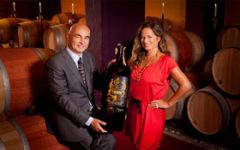Chateau Lalande-Borie 2015
-
James
Suckling -
Wine
Enthusiast -
Robert
Parker -
Jeb
Dunnuck -
Wine
Spectator



Product Details
Your Rating
Somm Note
Winemaker Notes
Blend: 55% Merlot, 45% Cabernet Sauvignon
Professional Ratings
-
James Suckling
Dark berries with chocolate and lightly toasted oak on the nose. Opens to a full body with silky tannins and a focused and fine finish. Shows tension and beauty. Drink or hold.
-
Wine Enthusiast
A dense wine with great fruit, this has a velvet texture and great elegance. There is structure of course from the firm tannins that stay in the background, while the main thrust of this wine is its great blackberry fruit. It will age and should be drunk from 2025.
-
Robert Parker's Wine Advocate
The 2015 Lalande-Borie is a blend of 45% Cabernet Sauvignon and 55% Merlot. Picked from 26 September until 2-3 October, it has a surprising bouquet: high-toned and exotic for the vintage, very intense cassis and iodine aromas, perhaps needing just a little more complexity to come through, though I am sure it will by the time of bottling. The palate is more controlled at the moment, restores order as it were. The tannins are quite dense, lending weight to this Lalande-Borie, the acidity is nicely judged and the finesse finally comes through towards the finish.
Barrel Sample: 89-91 -
Jeb Dunnuck
The 2015 Château Lalande-Borie is more perfumed and extroverted compared to the 2016 and gives up lots of ripe black cherry and strawberry fruit characteristics as well as more graphite, spring flowers, earthy minerality and toasted oak. Textured, medium-bodied, elegant and seamless on the palate, it shines more for its elegance and nuance than power. Drink it anytime over the coming 15-20 years.
-
Wine Spectator
On the softer side, with alluring mulled spice, black tea and warm fruitcake aromas and flavors emerging from the core of gently steeped plum and blackberry fruit. Perfumy mesquite and incense notes gild the finish. Best from 2019 through 2028.
Other Vintages
2016- Decanter
-
Wine
Spectator -
James
Suckling -
Wine
Enthusiast -
Jeb
Dunnuck
-
Wine
Enthusiast -
James
Suckling
-
Wine
Enthusiast -
James
Suckling
-
James
Suckling -
Wine
Spectator -
Wine
Enthusiast


Today, it is the Jean Eugene Borie company which belongs to Mrs. Borie and her daughter Sabine Coiffe and son Bruno-Eugene, which runs Chateau Lalande-Borie and Chateau Ducru Beaucaillou. It only took Chateau Lalande Borie a couple of years to acquire a great reputation.

One of the world’s most classic and popular styles of red wine, Bordeaux-inspired blends have spread from their homeland in France to nearly every corner of the New World. Typically based on either Cabernet Sauvignon or Merlot and supported by Cabernet Franc, Malbec and Petit Verdot, the best of these are densely hued, fragrant, full of fruit and boast a structure that begs for cellar time. Somm Secret—Blends from Bordeaux are generally earthier compared to those from the New World, which tend to be fruit-dominant.

An icon of balance and tradition, St. Julien boasts the highest proportion of classed growths in the Médoc. What it lacks in any first growths, it makes up in the rest: five amazing second growth chateaux, two superb third growths and four well-reputed fourth growths. While the actual class rankings set in 1855 (first, second, and so on the fifth) today do not necessarily indicate a score of quality, the classification system is important to understand in the context of Bordeaux history. Today rivalry among the classed chateaux only serves to elevate the appellation overall.
One of its best historically, the estate of Leoville, was the largest in the Médoc in the 18th century, before it was divided into the three second growths known today as Chateau Léoville-Las-Cases, Léoville-Poyferré and Léoville-Barton. Located in the north section, these are stone’s throw from Chateau Latour in Pauillac and share much in common with that well-esteemed estate.
The relatively homogeneous gravelly and rocky top soil on top of clay-limestone subsoil is broken only by a narrow strip of bank on either side of the “jalle,” or stream, that bisects the zone and flows into the Gironde.
St. Julien wines are for those wanting subtlety, balance and consistency in their Bordeaux. Rewarding and persistent, the best among these Bordeaux Blends are full of blueberry, blackberry, cassis, plum, tobacco and licorice. They are intense and complex and finish with fine, velvety tannins.
